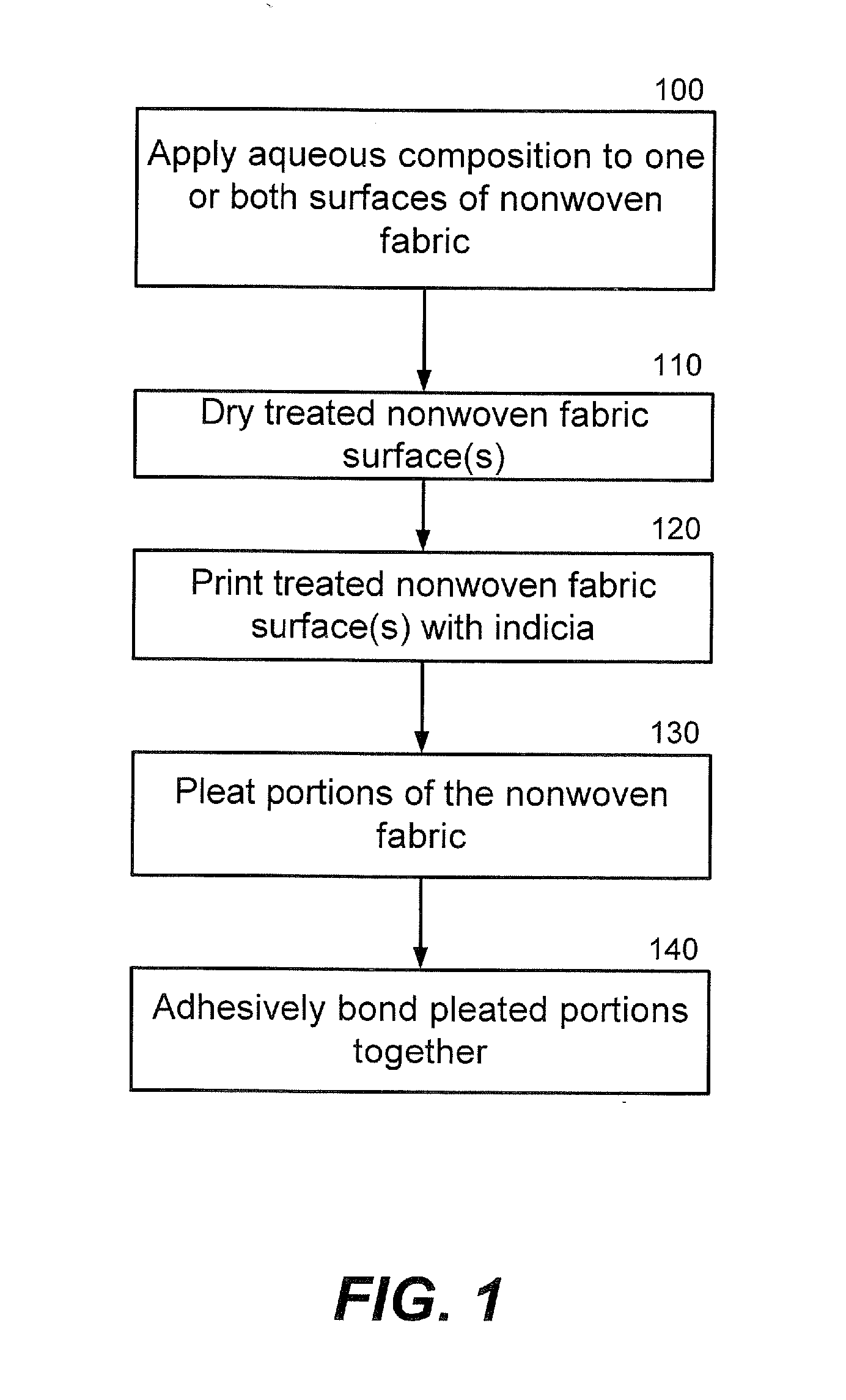Treated nonwoven fabrics and window shades incorporating same
a technology of non-woven fabrics and window shades, applied in the field of window shades, can solve the problems of window shades cell damage, glue not adhering properly to fabrics, and window shades may come apart during us
- Summary
- Abstract
- Description
- Claims
- Application Information
AI Technical Summary
Benefits of technology
Problems solved by technology
Method used
Image
Examples
example 1
[0023] A spunlaced nonwoven fabric comprised of polyester fibers, with an untreated basis weight of 68 gsm (grams per square meter), was immersed into a finish bath containing 0.5% by bath weight Isopropyl alcohol (penetrant), 0.8% by bath weight Rhoplex HA-16 (copolymer latex), 3.6% by bath weight Barpel SR-DA (fluorochemical stain-release agent), 0.9% by bath weight Zelec TY (antistatic agent), 0.9% by bath weight Zinc Omadine (antimicrobial agent) and 93.3% by bath weight of water. The finish bath was applied to the nonwoven fabric by a dip and nip technique (saturation finish) using a lab padder apparatus. The wet pick-up of the nonwoven fabric was about 140% in the finish bath. The wet fabric was then dried and cured in a lab oven set at 400° F. for a dwell time of 30 seconds.
[0024] Test results of the treated fabric are set forth below in Table 1:
TABLE 1Basis weight2.1 oz / yd2 (71 gsm)Grab tensile43 lbs. in the MD (machine direction) and18 lbs. in the XD (cross direction)Elo...
example 2
[0025] A spunlaced nonwoven fabric comprised of polyester fibers, with an untreated basis weight of 68 gsm, was foam finished using a bath containing 0.1% by weight of Unifroth 1672 (foaming agent), 4.7% by weight of Hystretch V-43HX (elastomeric copolymer), 1.7% by weight of Rhoplex TR-407 (acrylic latex), 7.0% by weight of Barpel SR-DA (fluorochemical stain-release agent), 0.9% by weight of Zelec TY (antistatic agent), 0.9% by weight of Zinc Omadine (antimicrobial agent), and 84.7% by weight of water. The finish bath was foamed on both sides of the nonwoven fabric at a wet pick-up of about 70% on each side. The foam finished fabric was then dried and cured in an oven set at 400° F. for a dwell time of 40 seconds.
[0026] Test results of the treated fabric are set forth below in Table 2:
TABLE 2Basis weight1.9 oz / yd2 (64 gsm)Grab tensile28 lbs. in the MD (machine direction) and14 lbs. in the XD (cross direction)Elongation54% in the MD and 247% in the XDCaliper (thickness)0.017 inch...
example 3
[0027] A spunlaced nonwoven fabric comprised of polyester fibers, with an untreated basis weight of 68 gsm, was foam finished using a bath containing 0.1% by weight of Unifroth 1672 (foaming agent), 4.7% by weight of Hystretch V-43HX (elastomeric copolymer), 1.7% by weight of Rhoplex TR-407 (acrylic latex), 7.0% by weight of Barpel SR-DA (fluorochemical stain-release agent), 0.9% by weight of Zelec TY (antistatic agent), 0.9% by weight of Zinc Omadine (antimicrobial agent), and 84.7% by weight of water. The finish bath was foamed on one side of the nonwoven fabric at a wet pick-up of about 70%. The foam finished fabric was then dried and cured in an oven set at 400° F. for a dwell time of 40 seconds.
[0028] According to other embodiments of the present invention, a test for determining the amount of stain resistance a nonwoven fabric exhibits in a window shade application is provided, and is referred to as the Precision Fabrics Group Stain Resistance Test (PFG ...
PUM
| Property | Measurement | Unit |
|---|---|---|
| temperature | aaaaa | aaaaa |
| dwell time | aaaaa | aaaaa |
| dwell time | aaaaa | aaaaa |
Abstract
Description
Claims
Application Information
 Login to View More
Login to View More - R&D
- Intellectual Property
- Life Sciences
- Materials
- Tech Scout
- Unparalleled Data Quality
- Higher Quality Content
- 60% Fewer Hallucinations
Browse by: Latest US Patents, China's latest patents, Technical Efficacy Thesaurus, Application Domain, Technology Topic, Popular Technical Reports.
© 2025 PatSnap. All rights reserved.Legal|Privacy policy|Modern Slavery Act Transparency Statement|Sitemap|About US| Contact US: help@patsnap.com

